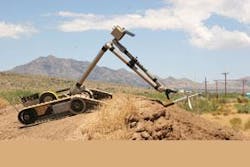By Courtney E. Howard
BURLINGTON, Mass.—Engineers at iRobot Corp. in Burlington, Mass., are developing a portable, communications relay robot for the U.S. Defense Advanced Research Projects Agency’s (DARPA) LANdroids program. Under this multi-year robotics research-and-development program, iRobot engineers are applying mobile robot design and production experience to deliver a robot that is small, inexpensive, intelligent, and robust.
The DARPA LANdroids program is to enable the warfighter to deploy and maintain a communications infrastructure in dense urban environments. The communications infrastructure is made up of several LANdroids mobile communications relay robots, which combine to form a reconfigurable communications backbone in support of operations.
“More than 1,300 of iRobot’s field-tested and combat-proven PackBot robots have been deployed in-theater delivering mission-critical support to warfighters around the globe,” says Helen Greiner, co-founder of iRobot, who chairs the company’s board of directors. “Research-and-development awards such as the DARPA LANdroids program enable us to continue driving innovation toward the next generation of revolutionary mobile, tactical combat robots that deliver advanced situational awareness and help keep warfighters out of harm’s way.”
iRobot will build the LANdroids robot. “This robot will be small enough that one dismounted warfighter can carry several robots, inexpensive to the point of being disposable, robust enough to allow the warfighter to drop and throw them into position, and smart enough to autonomously detect and avoid obstacles while navigating in the urban environment,” explains a company representative.
More than 1000 iRobot PackBots have been deployed in military applications, many of which are outfitted with the EOD (explosive ordnance disposal) Kit.
iRobot executives also have struck deals with technology firms to outfit the company’s PackBot with laser radar and tasers. In fact, iRobot engineers plan to employ laser-scanning technology in their future designs, which could be in use as early as 2009. Advanced Scientific Concepts Inc. of Santa Barbara, Calif., is providing the laser-vision system, described as a laser-light version of radar.
Engineers at iRobot and Taser International Inc. of Scottsdale, Ariz., have jointly developed a working proof-of-concept model of the iRobot PackBot Explorer with Taser X26 device. It is the first robot of its kind with an on-board, integrated taser payload. Built on the PackBot platform, the taser-equipped robots are designed to control dangerous suspects while keeping personnel and other innocents out of harm’s way.
“iRobot continually looks for new or proven technologies from best-of-industry companies to integrate on our battle-tested robots,” explains retired U.S. Navy Vice Admiral Joe Dyer, president of iRobot Government & Industrial Robots. “The addition of Taser technologies onto iRobot platforms will provide a critical tool for SWAT, law enforcement, and military to handle a variety of dangerous scenarios.”
iRobot is also under contract to develop the next-generation Small Unmanned Ground Vehicle (SUGV) for the U.S. Army’s Future Combat Systems (FCS) program. iRobot is working on the project with Science Applications International Corp. (SAIC), which serves as the FCS Lead Systems Integrator with Boeing. Army officials accelerated the testing schedules for iRobot’s FCS SUGV robot development program, calling for the delivery of 25 robots last month. This event marked the first significant delivery of SUGVs to military customers.

